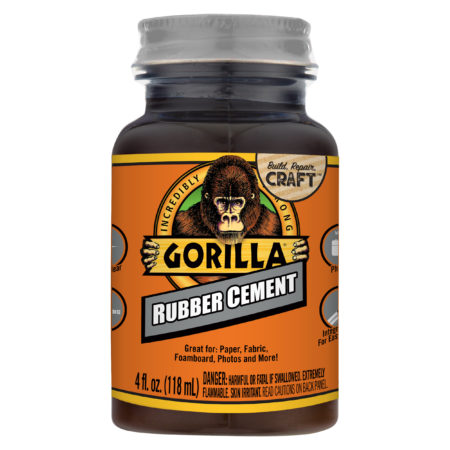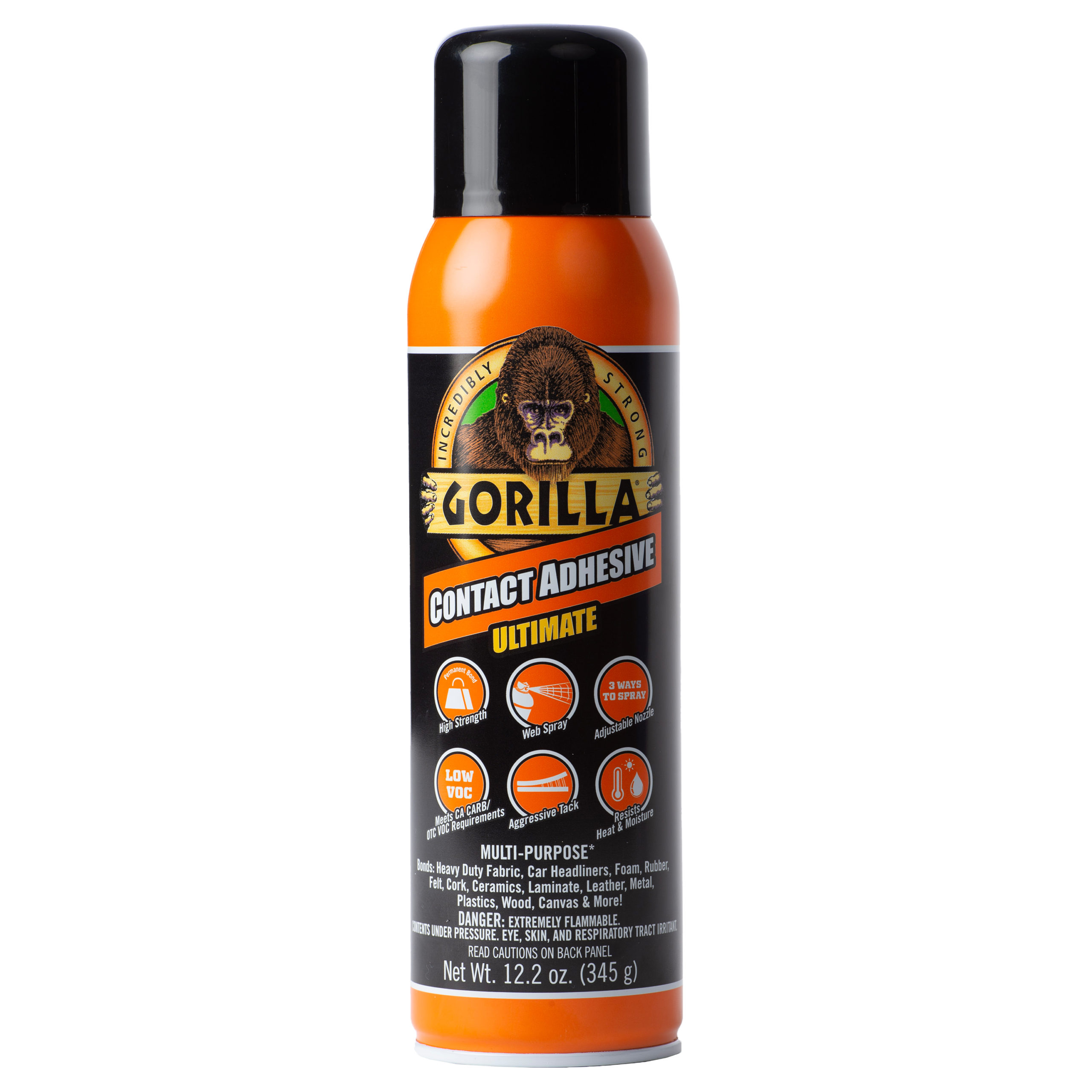Contact cement is best for bonding non-porous materials quickly, while Gorilla Glue is versatile for various materials. Both adhesives have strong bonding capabilities, but their applications differ based on the project’s requirements.
Contact cement creates an instant bond, ideal for laminates, veneers, and plastics. On the other hand, Gorilla Glue offers a strong, durable bond suitable for wood, stone, metal, ceramic, and more. Understanding the differences between these adhesives helps in choosing the right one for your specific project needs.
Now, let’s delve deeper into the unique features of contact cement and Gorilla Glue to determine which one suits your project best.
Introduction To Contact Cement And Gorilla Glue
The world of adhesives is vast, with numerous options available for various applications. Two popular choices often compared are contact cement and Gorilla Glue. Contact cement is a strong adhesive that forms an instant bond when two surfaces come into contact with each other. It is commonly used for bonding laminates, veneers, and other materials. On the other hand, Gorilla Glue is a versatile adhesive that expands as it cures, filling gaps and creating a strong bond. It is ideal for a wide range of materials, including wood, metal, and plastic. Both adhesives have their unique strengths and weaknesses, making them suitable for different projects. Contact cement offers immediate bonding, while Gorilla Glue provides a strong and durable hold. Consider the specific requirements of your project and the materials involved when choosing between these two adhesive technologies.
Chemical Composition
Contact Cement Ingredients: Contact cement typically contains neoprene and polychloroprene. It also includes toluene, acetone, and hexane as solvents. These solvents facilitate the drying process. On the other hand, Gorilla Glue Formula: Gorilla Glue is made from polyurethane. It expands as it dries, creating a strong bond. The foaming action helps the adhesive fill in gaps and voids.
Curing Mechanisms
Both contact cement and Gorilla Glue have unique curing mechanisms that set them apart. Contact cement sets through the process of evaporation, where the solvent evaporates, leaving behind a strong bond. On the other hand, Gorilla Glue’s bonding process involves moisture activation, as it requires the presence of water molecules to cure and create a durable bond. This fundamental difference in curing mechanisms affects the application and performance of these adhesives in various projects.
Adhesion Strength And Durability
Contact cement and Gorilla Glue are both popular choices for bonding materials, but they differ in terms of adhesion strength and durability. Contact cement offers excellent stress resistance, making it ideal for applications where the bonded materials may undergo frequent movement or stress. It forms a strong and lasting bond that can withstand heavy loads and vibrations. On the other hand, Gorilla Glue excels in longevity, creating bonds that are highly durable and resistant to moisture, heat, and impact. It is particularly suitable for projects that require long-term durability and can withstand harsh environmental conditions. Both adhesives have their strengths and it is important to consider the specific requirements of your project before making a choice.
Versatility And Material Compatibility
When it comes to versatility and material compatibility, contact cement and Gorilla Glue both offer unique advantages. Contact cement is ideal for substrates such as laminate, wood, and metal, providing a strong bond for various applications. On the other hand, Gorilla Glue is known for its multipurpose use, adhering to plastic, stone, fabric, and more. The versatility of Gorilla Glue makes it a popular choice for a wide range of materials, offering reliable adhesion for diverse projects.
For substrates suited for contact cement, laminate and wood are the top choices. Contact cement provides a secure bond for laminate surfaces, making it an ideal adhesive for countertops and cabinetry. Additionally, its compatibility with wood ensures strong and durable connections for woodworking projects. When it comes to material versatility, contact cement proves to be a reliable option for specific substrates.
Ease Of Use And Application
Contact cement and Gorilla Glue both offer ease of use and application, making them popular choices for bonding materials. Contact cement provides instant adhesion upon contact, while Gorilla Glue offers a strong hold with its versatile application on various surfaces.
Both options are user-friendly and efficient for different bonding needs.
| Contact Cement | Gorilla Glue |
| Working with Contact Cement | Applying Gorilla Glue Safely |
| Quick application with less mess. | Requires damp surfaces for bonding. |
| Best for large surface areas. | Works well on porous materials. |
| Strong odor; use in well-ventilated areas. | Expands as it cures; use sparingly. |
Curing Time And Clamping
Curing time and clamping are important considerations when comparing contact cement to Gorilla Glue. Both adhesives require adequate drying and setting time, but Gorilla Glue often requires clamping to ensure a strong bond. It’s essential to follow the instructions for each adhesive to achieve the best results.
| Set Times for Contact Cement | Gorilla Glue Curing Speed |
|---|---|
| Quick-drying, sets in minutes, strong bond | Requires longer curing time, slower process |
| Immediate clamping, ready for use swiftly | Allows for adjustment before full bond forms |
| Perfect for small projects, convenient application | Best for projects where time is not a concern |

Environmental Factors And Storage
Environmental factors can greatly affect the performance of adhesives. When it comes to contact cement and Gorilla Glue, proper storage is crucial to maintain their strength and effectiveness. Temperature, humidity, and exposure to light can all impact their bonding capabilities over time.
| Temperature and Humidity Effects: Store adhesives in cool, dry place. |
| Shelf Life and Storage Tips: Check labels for specific storage instructions. |
Cost Considerations
When comparing cost considerations between Contact Cement and Gorilla Glue, there are a few factors to consider. While Contact Cement tends to be less expensive, Gorilla Glue offers a stronger bond and may require less product to achieve the desired result, potentially making it more cost-effective in the long run.
| Affordability of Contact Cement | Value Proposition of Gorilla Glue |
| Contact cement offers cost-effective solutions for various projects. | Gorilla Glue provides premium quality at a slightly higher price point. |
| Comparing the two, contact cement is generally cheaper per ounce. | Gorilla Glue’s durability and versatility justify its higher cost. |
| For budget-conscious consumers, contact cement may be the preferred choice. | Gorilla Glue’s strength and reliability make it worth the investment. |

Safety And Health Precautions
When working with contact cement or Gorilla Glue, it is essential to prioritize safety and health precautions. Both adhesives contain toxic chemicals, requiring proper ventilation to minimize exposure. Always use personal protective equipment, including gloves, goggles, and a respirator, to safeguard against potential health risks.
User Experiences And Reviews
When it comes to comparing Contact Cement and Gorilla Glue, user experiences and reviews play a crucial role in decision-making. Community feedback on Contact Cement highlights its strong bonding ability and versatility, making it ideal for various projects. Users appreciate its quick drying time and long-lasting hold. Some have found it particularly effective for bonding materials such as wood, metal, and plastic.
Gorilla Glue, on the other hand, has garnered positive testimonials from users. Its strong adhesive properties and ability to bond different materials have impressed many. Users have praised its versatility and reliability, noting its effectiveness in various applications.
Considering the experiences shared by the community, both Contact Cement and Gorilla Glue offer reliable bonding solutions. The choice between the two ultimately depends on the specific requirements of the project and personal preference.
Conclusion And Recommendations
When choosing between contact cement and Gorilla Glue, consider the specific requirements of your project. Contact cement is best for bonding large surface areas, while Gorilla Glue is versatile and suitable for various materials. For optimal results, ensure that the surfaces are clean and dry before applying the adhesive. Apply the adhesive thinly and evenly, and use clamps or weights to hold the materials together while the adhesive sets. Always follow the manufacturer’s instructions for the best outcome. When considering the right adhesive for your project, evaluate the materials being bonded and the specific application to determine the most suitable option. By following the best practices for adhesive use, you can achieve strong and durable bonds for your projects.

Frequently Asked Questions
Is Contact Cement Better Than Gorilla Glue For Bonding Wood?
Contact cement and Gorilla Glue both work well for bonding wood, but they have different properties. Contact cement creates a strong, permanent bond, while Gorilla Glue expands as it dries, which can cause gaps in the bond. Consider the project requirements before choosing which adhesive to use.
Can Gorilla Glue Be Used On Plastic?
Gorilla Glue is not recommended for use on plastic as it may not bond properly. It is best suited for use on porous materials such as wood, metal, and ceramics. For plastic bonding, consider using a specialized plastic glue or an epoxy adhesive.
Can Contact Cement Be Used On Metal?
Contact cement is not recommended for use on metal as it may not bond properly. It is best suited for use on porous materials such as wood, fabric, and leather. For metal bonding, consider using a specialized metal glue or an epoxy adhesive.
Is Contact Cement Or Gorilla Glue Better For Outdoor Use?
Gorilla Glue is better suited for outdoor use as it is waterproof and weather-resistant. Contact cement may break down over time when exposed to the elements. However, for specific outdoor projects, consider using a specialized outdoor adhesive for maximum durability.
Conclusion
After comparing Contact Cement and Gorilla Glue, it’s clear that both adhesives have their own unique strengths and weaknesses. Contact Cement is ideal for bonding large surfaces and is resistant to high temperatures. On the other hand, Gorilla Glue is versatile and can bond almost anything.
Ultimately, the choice between the two depends on the specific needs of the project at hand. When selecting an adhesive, consider factors such as the surface being bonded, the application method, and the desired strength.

